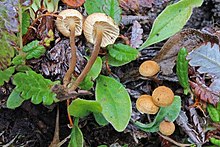| Rhizomarasmius epidryas | |
|---|---|

| |
| Scientific classification | |
| Domain: | Eukaryota |
| Kingdom: | Fungi |
| Division: | Basidiomycota |
| Class: | Agaricomycetes |
| Order: | Agaricales |
| Family: | Physalacriaceae |
| Genus: | Rhizomarasmius |
| Species: | R. epidryas |
| Binomial name | |
| Rhizomarasmius epidryas (Kühner ex A. Ronikier) A. Ronikier & M. Ronikier, 2011 | |
| Synonyms | |
| |
| Rhizomarasmius epidryas | |
|---|---|
| Gills on hymenium | |
| Cap is depressed or convex | |
| Hymenium is adnate | |
| Stipe is bare | |
| Spore print is white | |
| Ecology is saprotrophic | |
| Edibility is unknown | |
Rhizomarasmius epidryas (syn. Marasmius epidryas or Mycetinis epidryas) is one of a group of mushrooms formerly in the genus Marasmius. It grows amongst dwarf shrubs of the genus Dryas in arctic or high mountain environments.
Description
The species can be described as follows:
- The cap is brownish yellow and grows to about 1 cm in diameter.
- The gills are white and fairly distant, and broadly attached to the stem. The spore powder is white.
- The stem can grow to 4 cm tall by up to 2 mm in diameter, being broader at the apex. It is brown above and blackish brown at the base, with a velvety covering of hairs.
- The smell and taste are not distinctive.
- The spores are roughly ellipsoid or almond-shaped and measure roughly 8.5-10.5 μm x 5-7 μm.
Naming and related species
The species epithet is the Ancient Greek prefix "epi-" (ἐπί), meaning "on", followed by Dryas, the genus of plants with which it grows.
This species was originally described as Marasmius epidryas by Robert Kühner in 1935 in the annals of the Linnaean Society of Lyon, but the definition was considered invalid due to the lack of a Latin description according to the updated nomenclatural rules. In 2009 Anna Ronikier published a correct description ascribing the name to Kühner (that is, giving credit to him) and so the first valid name with author attribution was "Marasmius epidryas Kühner ex A. Ronikier". Then in 2011 Anna & Macheł Ronikier established that the species belongs in the new genus Rhizomarasmius and redefined the current name accordingly.
Ecology and distribution
This mushroom is found exclusively in cushions of Dryas plants such as D. octopetala (mountain avens) and D. integrifolia (entire-leaved avens), growing saprobically on dead leaves and stems. It only occurs in arctic or high mountain environments.
It is reported from Arctic regions of Europe and North America, the Rocky and Altai mountains, and various mountain ranges in Europe.
References
- ^ "Rhizomarasmius epidryas page". Species Fungorum. Royal Botanic Gardens Kew. Retrieved 2018-11-03.
- ^ Antonín, V.; Noordeloos, M. E. (2010). A monograph of marasmioid and collybioid fungi in Europe. Berchtesgaden, DE: IHW Verlag. pp. 408–410. ISBN 978-3-930167-72-2.
- ^ Knudsen, H.; Vesterholt, J., eds. (2018). Funga Nordica Agaricoid, boletoid, clavarioid, cyphelloid and gasteroid genera. Copenhagen: Nordsvamp. p. 361. ISBN 978-87-983961-3-0.
- Moser, Meinhard (1983). Keys to Agarics and Boleti (Polyporales, Boletales, Agaricales, Russulales). London: Roger Phillips. p. 167. ISBN 0-9508486-0-3.
- Liddell, Henry George; Scott, Robert. A Greek-English Lexicon. Oxford University Press. Retrieved 2018-11-03.
- Ronikier M, Ronikier A (2011). "Rhizomarasmius epidryas (Physalacriaceae): phylogenetic placement of an arctic-alpine fungus with obligate saprobic affinity to Dryas spp". Mycologia. 103 (5): 1124–1132. doi:10.3852/11-018. PMID 21482630. S2CID 42900871.
| Taxon identifiers | |
|---|---|
| Rhizomarasmius epidryas | |
| Marasmius epidryas | |